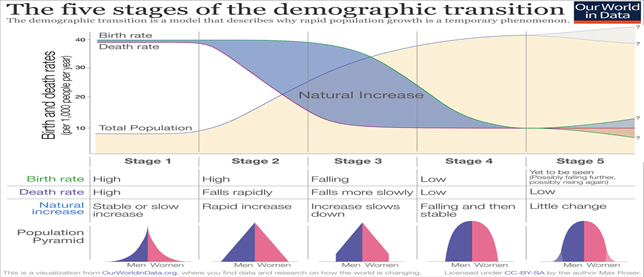Social Issues
Context: Though the global population, in terms of numbers, has been steadily increasing — some reports suggest that it could grow to around 8.5 billion in 2030 — there is an interesting aspect to this: average global fertility has been consistently declining over the past 70 years.
- The average number of children per woman in the reproductive age group has declined by 50%, from an average of 5 children per woman in 1951 to 2.4 children in 2020, according to the World Population Prospects (WPP) 2022 by the United Nations population estimates and projections, and prepared by the Population Division of the Department of Economic and Social Affairs of the United Nations Secretariat (UN-DESA).
WPP 2022 Findings Related to India :
- India’s growth rate stood at 3 % in 1972, which has dropped down to less than 1% now.
- In this period, the Total Fertility Rate (TFR) has come down from about 5.4 to less than 2.1 now.
- This means that Indian has attained the Replacement Level Fertility (RLF) Rate, at which a population exactly replaces itself from one generation to the next.
Reasons for changing trend of population:
- This is the result of speeding up the social phenomenon of demographic transition.
- Demographic transition refers to the historical shift from high birth rates and high death rates in societies with minimal technology, education (especially of women) and economic development, to low birth rates and low death rates in societies with advanced technology, education, and economic development, as well as the stages between these two scenarios.
- Poorer countries seem to be speeding up the transition ladder a lot faster than the richer ones.
- The newly released World Population Prospectus also notes that the global fertility rate fell from three in 1990 to 2.3 in 2021. Sub-Saharan African countries are expected to contribute more than half the population growth after 2050 and grow through 2100. Most advanced economies have their fertility rate below the replacement rate of 2.1.
Indian scenario:
- The Indian setting is no different, with its fertility rate falling below the replacement level for the first time to 2.0 in 2021, according to the latest National Family Health Survey 2021 (NFHS- 5). The rate has dipped 10% in just five years.
- At the time of Independence, India’s fertility rate (TFR) was 6 per woman, and it had taken 25 years to reach 5, with the government launching the first ever family planning programme in the world in 1952.
- As reported by the NFHS 2021, only five States have a fertility rate above the replacement rate: Bihar, Meghalaya, Uttar Pradesh, Jharkhand, and Manipur.

Advantages of having low fertility rates:
- Lower fertility impacts women’s education positively, which in turn lowers the fertility of the next generations.
- With better infrastructure development, better health care, and education, fertility drops and income rises.
- Demographic Dividend– The spiral of lower fertility leads to a window of time when the ratio of the working-age population is higher than that of the dependent age groups.
- This high proportion of people in the workforce boosts income and investment, given the higher level of saving due to lower dependence.
- The falling fertility rate will also lead to lower pressure on land, water and other resources and would also contribute to achieving environmental goals.
However, A fall in fertility rate beyond replacement level would have a negative effect on the proportion of the working population:
- TFR < RLF will negatively affect output in an economy.
- A rise in education and independence among women would enhance their labour participation, which could arrest the fall in labour participation up to a limit.
- An influx of immigrants from countries with higher population growth could also play a positive part but this would change local demography, leading to political unrest.
- A paper, “The End of Economic Growth? Unintended Consequences of a Declining Population”, by Stanford economist argues that falling fertility could diminish the creative capacity of humankind. He points to the need for ideas in technological advancement and productivity boost, which even artificial intelligence is still not capable of.
- An ageing population will also affect global interest rates negatively as the share of people over 50 years will form almost 40% of the population by 2100.
- In their book The Great Demographic Reversal, economists explain how falling fertility will have a positive effect on inflation through higher wages due to lower labour supply and a change in the nature of unemployment inflation trade-off, as now low inflation can be maintained even with low unemployment.
Way forward: Dealing with fertility decline
- The fall in fertility around the globe has been a result of decades of demographic process, and hence needs scientific and sustainable policies for mitigation.
- The advancement in health care and better nutrition around the world have increased the life expectancy and productivity of older citizens.
- Countries across the globe are experimenting with policies to boost fertility.
- Germany found success in boosting births through liberal labour laws, allowing more parental leave and benefits.
- Denmark offers state-funded IVF for women below 40 years, and Hungary recently nationalised IVF clinics.
- Poland gives out monthly cash payments to parents having more than two children, whereas Russia makes a one-time payment to parents when their second child is born.
- Liberal labour reforms, encouraging higher female labour force participation rate, and a higher focus on nutrition and health would ensure sustained labour supply and output despite lower fertility.
Source: The Hindu
Previous Year Question
Q.1) Which of the following organizations brings out the publication known as ‘World Economic Outlook’? (2014)
- The International Monetary Fund
- The United Nations Development Programme
- The World Economic Forum
- The World Bank












